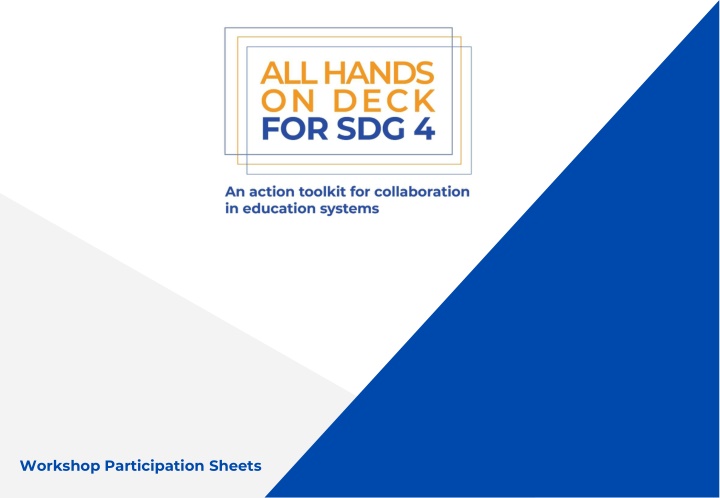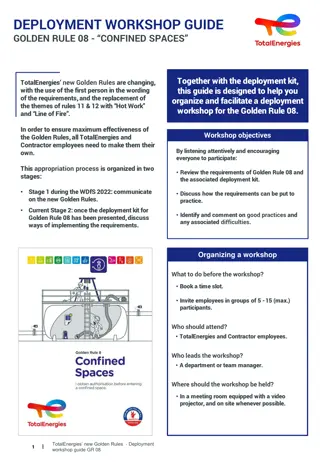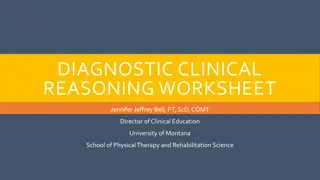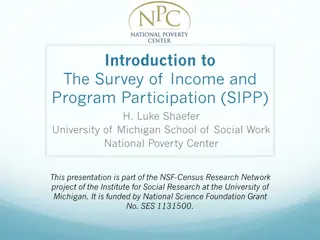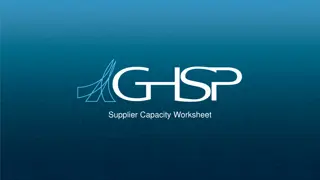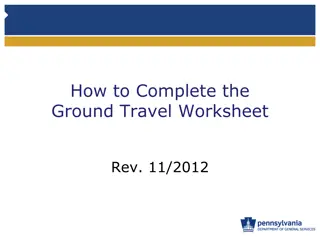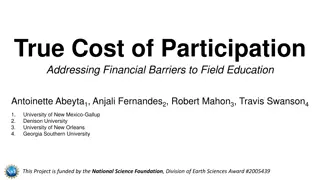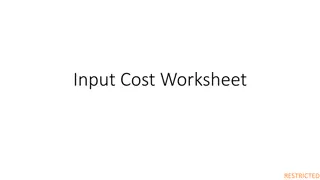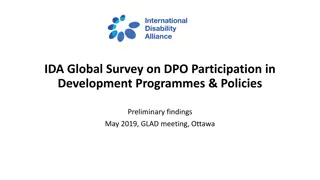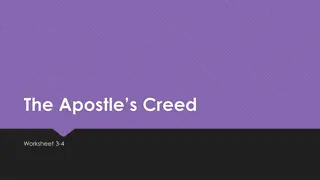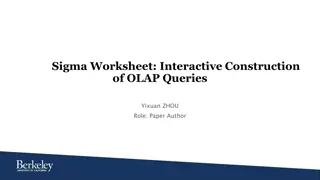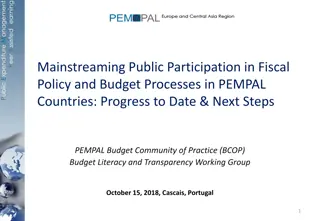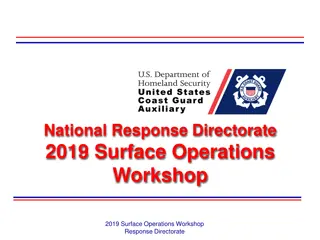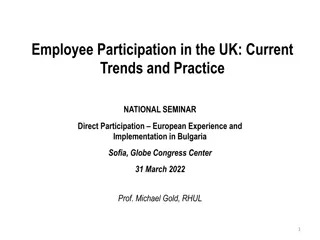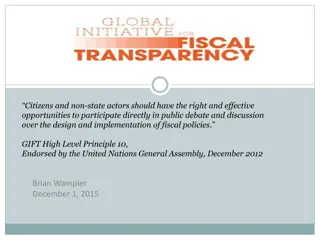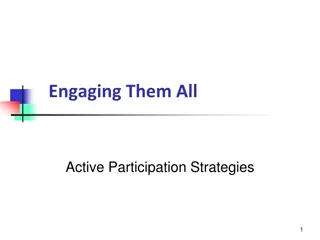Worksheet for Workshop Participation
Utilize these worksheets to set intentions, map characteristics and assets, identify strengths and areas for improvement, and explore opportunities for your work in a workshop setting. The interactive sessions aim to enhance your engagement with government and foster productive collaborations.
Download Presentation

Please find below an Image/Link to download the presentation.
The content on the website is provided AS IS for your information and personal use only. It may not be sold, licensed, or shared on other websites without obtaining consent from the author.If you encounter any issues during the download, it is possible that the publisher has removed the file from their server.
You are allowed to download the files provided on this website for personal or commercial use, subject to the condition that they are used lawfully. All files are the property of their respective owners.
The content on the website is provided AS IS for your information and personal use only. It may not be sold, licensed, or shared on other websites without obtaining consent from the author.
E N D
Presentation Transcript
Worksheet 1: Setting your intentions Use these boxes to chart what your intentions are for today. Keep your responses to come back to later. Part 1: Where are you going, and how can this session help you get there? Part 2: Compare your notes 10 Minutes 10 Minutes Speaking to someone else in the group, what is similar about your intentions and the challenges you face? What is your goal for fostering more productive engagement with government? What challenges do you face in doing this? What is different? What does an ideal future look like for you? How can this workshop support you in getting here?
Worksheet 2a: Mapping Characteristics and Assets Use the boxes below to chart your characteristics and assets. The questions on the reverse should guide your discussions. Part 1: What characteristics and assets will help you in your work? 30 Minutes Characteristics and Assets Commitment Change is fostered by commitment. This can be achieved by local organisations with deep roots, or outside organisations willing to make long term commitments. Alignment This means alignment within an organisation, in terms of having a clearly defined, consistent message, as well as alignment with government priorities and policies. Technical Capability As an organisation, having a specific and clearly defined technical niche is an asset for building collaboration and credibility. Skilful Leadership Change is often driven by skilful individual leadership within organisations which can drive and shape agendas and build relationships.
Part 2: Where are your strengths? What would you like to strengthen? 10 Minutes Looking at your characteristics and assets, which of the four areas do you think is strongest for you? How will this help you in your work? Which area do you think you could improve upon? How would you plan to do this?
Worksheet 2b: Mapping Opportunities Use the boxes below to chart the opportunities around you. The questions on the reverse should guide your discussions. Part 1: What opportunities exist in your context to support your work? 20 Minutes Opportunities Timing Change takes time, and enacting change relies on patience to wait for change, trust to persist with activities, and opportunism to act when opportunities arise. Policy Windows Opportunities for change can arise suddenly from changes in policy. Whether these arise from long advocacy processes, or shifts in political landscape, they create an opportunity for change. Political & Social Context Education is an important public issue. Understanding the public s view of the issue, and how this relates to the political position can build understanding of opportunities. Ecosystems Who else is working around you? The presence of other aligned actors with complimentary skills can create an opportunity for collaboration and change.
Part 2: Where are your strengths? What would you like to strengthen? 10 Minutes In which of the areas discussed do you see an opportunity for change? How could you take advantage of this opportunity?
Worksheet 3: Activity Checklists Use the form below to reflect on how well your current activities are suited to building engagement. Use part two to get advice from your peers. Part 2: Strengthening your work Part 1: What areas are you doing well in, and where do you want to improve? 10 Minutes 30 Minutes Doing OK Needs Work Doing Great Which area do you want to improve? When generating evidence, we a. b. Frame evidence within a clear narrative. Align evidence to the questions being asked in the sector. Involve a wide coalition in evidence generation. Who did you speak to who said they are doing great in this? c. In building coalitions, we What advice did they give? a. b. c. d. Establish alignment around a common goal. Establish trust and commitment. Integrate diverse perspectives. Work to build formal authority. As a funder, we a. b. Fund with trust and commitment. Fund momentum, don t use funding to generate momentum Take a backseat and let the initiative take centre stage c.
Use the boxes below to draw a theory of change, using the activities you spoke about during activity 3. You can use the problems and outcomes from the action framework if they are relevant for you. Worksheet 4: Activity Pathways for Change 30 Minutes Problem Activities Intention Outcome What are the barriers to better engagement? What activities can you undertake? How can they be aimed at fostering engagement? What will the outcomes be? Impact System Level Goal: public & private seen as one system, supported by government oversight & partnerships; and delivering goals of equity & learning
Use the boxes below to draw a theory of change, using the activities you spoke about during activity 3. You can use the problems and outcomes from the action framework if they are relevant for you. Worksheet 4: Activity Pathways for Change 20 Minutes Activities Problem Outcome What activities do you undertake? What will the outcomes be? What are the barriers to better engagement? Impact a) Evidence Generation System Level Goal: public & private seen as one system, supporte d by government oversight & partnerships; and delivering goals of equity & learning b) Coalition Building c) Catalytic Funding
Use the self-assessment below to reflect on where you were before today, and how that may have changed over the course of the session. With a colleague, go through the discussion questions. Worksheet 5: Final Reflections Part 2: Discussion Part 1: What are your reflections on today s session? 10 Minutes 10 Minutes Some what Not at all A lot How prepared do you feel to work more proactively on building engagement? a. To what extent do you have the characteristics and assets you need to enact change? To what extent does the context you re in currently provide opportunities for fostering better engagement? Before today, how clear were you on your strategy for improving engagement with the government? Before today, to what extent did you integrate thinking on engagement into your regular activities? To what extent will you now continue to work on your strategy for improving engagement? How clearly do you think you can articulate the pathway to fostering better engagement? How ready do you feel to lead on fostering better engagement between state and non- state actors in your context? What will be your first steps? b. c. d. What challenges do you imagine you will face? e. f. What will help you overcome them? g.
